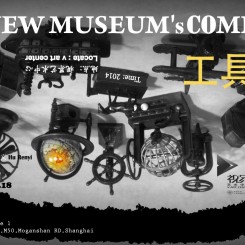More and more organizations within China have begun to categorize themselves as non-profit organizations, to such an extent that even galleries have begun to style themselves as non-profit spaces. Thus the term “non-profit” has become somewhat ambiguous, and simply refraining from the sale of art works does not qualify an organization to fall underneath this umbrella, neither does the sale of work to fund projects exclude a space from the non-profit label. Located in Shanghai’s M50 art district, V Art Center has flourished since its founding in 2010, holding numerous group exhibitions of young artists’ works as well as solo shows. They have mostly worked with their sponsor the Shanghai Institute of Visual Arts (formerly known as Shanghai Fudan School of Visual Arts), but have also worked in concert with various schools and cultural institutions both foreign and domestic. Recently, randian editor Gu Ling interviewed V Art Center’s curator Chao Jiaxing about the center’s current situation and vision for the future.
Guling (GL): Please briefly discuss V Art Center’s organizational and financial position.
Chao Jiaxing (CJX): V Art Center resides in two spaces within the M50 art district. The first space is located in building three on the second floor, and the second in building six, unit 104. T Shanghai Institute of Visual Arts (formerly known as Shanghai Fudan School of Visual Arts). pays the rent, utility bills, salaries, and other fixed overheads. The art director of our center is the artist Ding Yi who is also employed at the institute as the assistant dean. The center receives relatively fixed funding annually to split between the two spaces, which covers the operating expenses for four exhibitions. We are able to hold these four exhibitions in large part due to efforts by professor Ding. Usually, we plan and execute all four exhibitions ourselves; otherwise, we work cooperatively with the cultural exchange sectors of various nations’ consulates. In the past, we have worked with both the Netherlands and Switzerland. Of course, we also seek sponsorship from various sources based on the specific circumstances of each exhibition; we typically receive sponsorship in kind, or sponsorship for services.
GL: Does V Art Center sell work?
CJX: We do not attempt to initiate sales with visitors, and we do not mark pieces with price tags. Even if visitors or collectors interested in young artists express their intent to purchase, we always consult the artist before selling. We take a percentage of the proceeds from the sale for future operating expenses.
GL: Does V Art Center act as an agent for artists?
CJX: We don’t have fixed relationships with individual artists. In other words, we may act as agents for a specific work in an exhibition, or a series of works by an artist, or works produced within a specific timeframe.
GL: Most artists who work with V Art Center are very young. Is supporting young artists part of the main operating strategy for the center?
CJX: We mainly use the following principles to guide the planning of our exhibitions. First, we try to facilitate the exchange and participation of artists from within and China and abroad. Second, we want to encourage and guide the works and projects of experimental artists. Third, we tend to invite local emerging artists to exhibit at our spaces. Finally, this year we are interested in planning more projects which transcend the boundaries of disciplines. We hope to enrich the content displayed in our spaces by expanding beyond what is conventionally accepted as contemporary art, and extend into the fields of design, cinema, magazines, technological innovation (like Xinchejian–the first hackerspace in Shanghai), and other creative fields. We intend to participate in the planning and realization of these links, forging deeper and closer ties between these different creative fields. This will increase the level of interest in our events from outside the industry, and increase our understanding of experimental art, giving us different perspectives. We will also focus on exhibiting outstanding graduate projects by MFA students from foreign schools and institutions (in the same vein as the digital arts festival spearheaded by the New York School of Visual Arts’ computer animation MFA program in conjunction with their school of music showcasing works by mature artists). In addition to this, we will also look to taking on projects similar to Today Art Museum’s annual invitational exhibition for students of contemporary art academies. In these ways, we hope to make our focus more pluralistic and innovative.
GL: You simultaneously fill the role of curator and manager of the center’s daily operations. How do you balance these two roles?
CJX: As the person in charge of daily operations, I manage finances and develop exhibition policies. Personally, I believe maintaining the center’s long-term expectations and operations means we have to develop something similar to a brand concept. On the other hand, as a curator, I must gain a deep understanding of the artists and their works. I believe this to such an extent that I always engage in long-term communication with the artists we feature in order to achieve a sufficient understanding of their work. I don’t limit my interest in the artist’s visual presentations; I also focus on the relationship between the artists as individuals and their finished creations. This is why I’m often able understand the artist’s creative intent as soon as I see their new works. Regrettably, I’ve discovered a lack of introspection in many young artists. As their works are absorbed by the market, and the speed of their output increases, they gradually and subtly become influenced by their surroundings, and lose their initial creative potency. They stop analyzing how they, as individuals, are linked to their creations. Personally, I hope I’m able to maintain a balance of introspection, and provide artists with a way to maintain self-awareness when we work together. I feel I’m very fortunate because I can switch between these two roles; I’m not entangled in issues with division of labor, or the negative tendency of larger organizations toward imperfect compromise.
GL: Do you plan to curate any exhibitions independent of V Art Center?
CJX: I’ve always understood that an organization is propelled by the abilities of its people. This may seem a bit extreme, but especially in the case of a smaller space, I really believe this is true. Often, when an artistic organization has a change in ownership or management, we observe a huge shift in their operations, from personnel through to policy. I hope to maintain my self-awareness and resourcefulness, and wish to pass these two traits onto the space. Of course, the space will inevitably reflect my individual preferences. On a certain level, maintaining the balance between the space and the individual is a mutually reflective process. Personally, I feel I was destined to work here. Even when I was a graduate student, I participated in setting up shows at this center, and my first job upon graduating was here as well.
GL: What is the current situation, and what prospects is V Art Center facing as a non-profit space?
CJX: Overall, I think most non-profit spaces in China face issues with lack of funding, and lack of attention. Media presence and literature are effective ways to attract sponsorship. Keeping in contact with the media even after an exhibition ends is important; so is the editing of literature to generate interest. A problem we face in China is the total lack of support for non-profit spaces by the government; this is very different overseas. V Art Space is fortunate because it’s organized by the institute, and our freedom with regards to content is relatively protected, which also maintains the attractiveness of our space to a certain degree. Overall, I think V Art Center is an extremely unique example in the domestic art world—we’re sponsored by an art institute, but we curate independently, and we’re committed to bringing about fresh, innovative projects. Our art director, Professor Ding will often personally purchase and collect artists’ works to encourage and support their creative efforts.
GL: Among the non-profit spaces you know of within China, can you think of one you’d say is exemplary?
CJX: I’ve always liked Vitamin Creative Space and used it as an inspirational goal for myself. The way they work is very energetic, and they don’t set conceptual limitations. I especially like “The Pavilion” as a platform for discussion and exchange of ideas. They’ve done very well from an international perspective. Many projects in China lack this very sense of flexibility and fineness. I want to learn from their experiences and channel these things into V Art Center, finding opportunities for continued growth.
GL:We are very keen to hear about your upcoming projects, can you tell us briefly about what you have planned for the future?
CJX:We will have two openings in March. In the first space we will have a fun show called “A New Museum’s Coming!”We’ve invited a publisher, magazine editors, columnists, art historians and artists, to bring out their collections of pencil sharpeners, to make a mini-museum in response to this problem we are currently faced with which is “the space is too big for the small number of works.”In the second space is Ye Funa’s solo show “News from Nowhere”—a continuation of her aesthetic investigations into folk culture in Shiman Village near Lijiang, Yunnan,she interviewed young villagers in the idyllic scenery, amongst fields, grasslands and lakes about not returning to these “utopian villages.”




